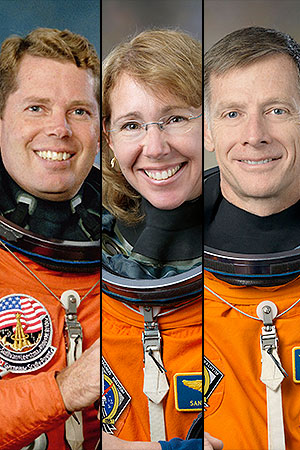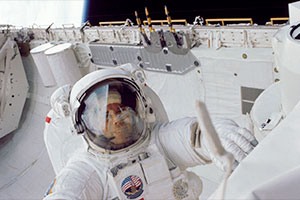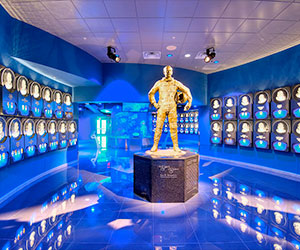February 15, 2022 — An astronaut who launched on the first space shuttle to fly with a full crew and two crew members who flew on the last space shuttle to launch will be honored later this year for their contributions to the United States' space program.
David Leestma, Sandy Magnus and Chris Ferguson were announced as the next class of U.S. Astronaut Hall of Fame inductees on Tuesday (Feb. 15). The three veteran space travelers will formally enter the hall during a public ceremony to be held on June 11 under the display of the retired space shuttle Atlantis — an orbiter on which all three flew — at the Kennedy Space Center Visitor Complex in Florida.
"We are pleased ... [to] welcome these accomplished individuals into the United States Astronaut Hall of Fame. All three have demonstrated the characteristics that define a Hall of Famer: heroism, commitment and bravery," Curt Brown, a former space shuttle astronaut, 2013 Hall of Fame inductee and board chairman of the Astronaut Scholarship Foundation, which oversees the selection process, said in a statement.
Leestma, Magnus and Ferguson will raise the U.S. Astronaut Hall of Fame's ranks to 105 out of the 360 men and women that NASA has chosen to train over the past 63 years.
Seven up
A naval flight officer who became an astronaut in 1980 with NASA's second class of space shuttle astronauts, Leestma made his first spaceflight on the first shuttle mission to carry a full complement of seven astronauts.
Serving as a mission specialist on the space shuttle Challenger, Leestma and his six STS-41G crewmates lifted off in October 1984. During the mission's eight days in orbit, Leestma helped deploy a satellite designed to measure solar energy, including using the shuttle's robotic arm to free a stuck solar array. Leestma also performed the first spacewalk to include an American woman (Kathy Sullivan, who was inducted into the Astronaut Hall of Fame in 2004), and together they validated a technique for refueling satellites on-orbit.
Leestma launched on his second spaceflight in 1989 aboard the orbiter Columbia, serving on the fourth shuttle mission dedicated to Department of Defense (DoD) activities. The mission details of STS-28 are still secret today, but what is known is that Leestma acted as a liaison between the DoD, NASA and the space agency's contractors to support the flight's classified payload.
Leestma's third and final mission was aboard Atlantis as a member of the STS-45 crew. As a mission specialist, Leestma demonstrated the ability for a non-pilot astronaut to command a spacecraft and operate on-orbit vehicles by serving as a shift commander for the first Atmospheric Laboratory for Applications and Science (ATLAS-1) Spacelab payload. The nine-day mission landed in April 1992.
In total, Leestma logged 22 days, 4 hours and 32 minutes in space, including three and a half hours on his one spacewalk.
Following his last return to Earth, Leestma served as the deputy chief and acting chief of the astronaut office prior to becoming director for flight crew operations, a position that gave him responsibility for the astronaut corps and aircraft operations at Johnson Space Center. In this role, Leestma ensured that NASA's fleet of T-38 training jets were retained and upgraded and he worked closely with his Russian counterparts to successfully carry out seven shuttle flights to the Mir space station (phase one of the International Space Station program).
Leestma held several other management positions at Johnson before retiring from NASA in 2014. In the years since, he has facilitated executive leadership training and was a member of the team that developed what later became NASA's Artemis program, in addition to taking part in educational outreach activities to promote an interest in science, technology, engineering and mathematics (STEM) topics.
Last, but not Leest-ma
Magnus' and Ferguson's NASA careers followed similar paths, including launching together on two of their three missions.
Selected with the 16th and 17th classes of NASA astronauts in 1996 and 1998, respectively, Magnus and Ferguson made their first spaceflights on missions that delivered parts for the International Space Station's backbone truss.
Magnus, an engineer who previously worked on stealth aircraft design, first lifted off as an STS-112 mission specialist on the space shuttle Atlantis in October 2002. During the 11-day mission, she served as robotics officer, overseeing the delivery and installation of the Starboard 1 (S1) truss segment by using the space station's Canadarm2 robotic arm.
A test pilot in the U.S. Navy, Ferguson served as the pilot on his first space shuttle mission, flying with the STS-115 crew on Atlantis in September 2006. Delayed by three years due to the loss of the space shuttle Columbia and its crew, Ferguson and his crewmates delivered the second port-side truss segment (P3/P4) and two solar arrays for the space station.
Magnus and Ferguson then launched together on their second mission, STS-126, on board the orbiter Endeavour in November 2008. Ferguson served as mission commander, while Magnus transferred from the shuttle to the Expedition 18 crew on the station, where she lived and worked for more than 130 days. Ferguson, meanwhile, oversaw his crew's activities repairing a critical joint used to rotate the station's arrays before returning to Earth to make a landing on a temporary runway at Edwards Air Force Base in California (it was only the fourth runway using by the space shuttle). (Magnus later returned home with Discovery's STS-119 crew.)
Ferguson and Magnus completed their NASA astronaut careers serving as half of the contingent for the historic final mission of the space shuttle program. Ferguson as commander and Magnus as mission specialist joined their two other STS-135 crewmates for a last visit to the International Space Station during the 13-day flight by the space shuttle Atlantis flight in July 2011.
Magnus logged a total of 157 days, 8 hours and 43 minutes in space. Ferguson's total time in space as a NASA astronaut was 40 days, 10 hours and 3 minutes.
Ferguson left NASA in December 2011 to lead flight crew and mission operations for Boeing's CST-100 Starliner crew spacecraft. Ferguson was assigned to lead the Starliner's crew flight test as Boeing's first commercial astronaut, but withdrew from the mission, now scheduled to launch as soon as later this year, for personal reasons.
Magnus retired from NASA in 2012 and was appointed executive director of the American Institute of Aeronautics and Astronautics (AIAA) for five years. She then served as the deputy director for engineering for the Office of the Undersecretary of Defense for Research and Engineering at the Department of Defense. Magnus now serves on several technical advisory boards and is a part-time Professor of the Practice at the Georgia Institute of Technology.
Hall-owed history
The U.S. Astronaut Hall of Fame was originally proposed more than 30 years ago by the then-six surviving members of the Mercury 7 astronauts. Established in 1990, the Hall of Fame became part of the Heroes & Legends attraction at NASA's Kennedy Space Center Visitor Complex in November 2016.
As with past inductee classes, Leestma, Magnus and Ferguson were chosen by a committee of earlier enshrined astronauts, former NASA officials, flight directors, space historians and journalists. The selection process is administered by the Astronaut Scholarship Foundation. To be eligible, nominees must have made his or her first flight at least 17 years prior to the induction year, must be a U.S. citizen and have been a NASA-trained commander, pilot or mission specialist who orbited Earth at least once.
Following their June 11 induction ceremony, Leestma, Magnus and Ferguson will be celebrated at an evening black-tie gala hosted by the scholarship foundation. |
|

The 2022 class of U.S. Astronaut Hall of Fame inductees includes space shuttle veterans David Leestma (at left), Sandy Magnus and Chris Ferguson. They will be enshrined at a June 11, 2022 public ceremony at the Kennedy Space Center Visitor Complex. (NASA)

NASA astronaut David Leestma, as seen as an STS-41G mission specialist on board the space shuttle Challenger in 1984. (NASA)

Astronaut David Leestma performs a spacewalk in the payload bay of space shuttle Challenger during the STS-41G mission. (NASA)

2022 Astronaut Hall of Fame inductees Sandy Magnus and Chris Ferguson, as seen on on the aft flight deck of the space shuttle Atlantis during the final space shuttle mission, STS-135. (NASA)

2022 Astronaut Hall of Fame inductees Chris Ferguson and Sandy Magnus (at right) with past inductees Bob Crippen and John Young in a photo with first and last space shuttle crew members. (NASA)

The U.S. Astronaut Hall of Fame, as featured in Heroes & Legends at the Kennedy Space Center Visitor Complex in Florida. (KSCVC) |
